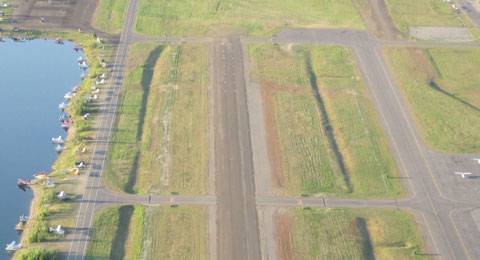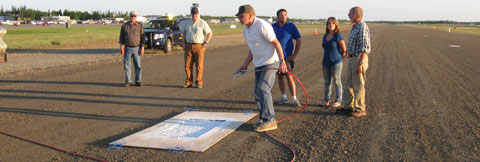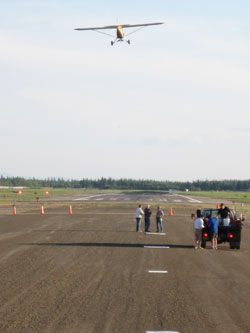
You’ve been landing on long, paved runways all year. Now it is summer—time to head for the backcountry. Are you up to the piloting tasks ahead?
The time to get some specialized practice is before attempting that first landing of the year on a narrow gravel bar, or that first takeoff from that short, rough surface with a heavy load of camping supplies and freshly caught fish. Even if your flight review and recency-of-experience obligations are met, a mission-specific workout is a good decision.
The Alaska aviation community knows the importance of staying sharp on max-performance takeoffs and landings. Aviation groups there have now teamed up with the FAA to provide an experimental program at two airports where pilots can practice off-airport landings on simulated short gravel surfaces that offer an unbeatable safety margin: they are marked-off portions of longer gravel runways.
The program started June 7 at Fairbanks International Airport and Palmer Municipal Airport.

“In a collaborative effort by the FAA, Fairbanks International Airport and several aviation organizations, pilots will have a chance to practice at home,” said the General Aviation Association at Fairbanks in a news release.
The 600-foot-long by 25-foot-wide practice runway in Fairbanks was marked by applying paint directly to the gravel surface after the FAA had reviewed the markings. Labor and equipment were provided by GA Association at Fairbanks, AOPA, The Ninety-Nines, and the University of Alaska at Fairbanks Aviation Maintenance Technology Program.
 “Pilots are welcome to make takeoffs and landings to see if they can get down and stopped before running off the end of the marked area,” the GA Association release said. “Given that the markings are in the middle of a larger conventional runway surface, the consequences of not getting it right the first time are more to the ego than to the airplane, with the opportunity to try, try again.”
“Pilots are welcome to make takeoffs and landings to see if they can get down and stopped before running off the end of the marked area,” the GA Association release said. “Given that the markings are in the middle of a larger conventional runway surface, the consequences of not getting it right the first time are more to the ego than to the airplane, with the opportunity to try, try again.”
At the 24-hour, tower-controlled Fairbanks airport, the simulated gravel bar is established on the field’s 2,900-by-75-foot ski strip. Pilots planning to use it for practice simply notify the tower of their intentions and are worked in with the other traffic, said Angela Spear, the airport’s public information officer.
A practice area of the same dimensions was established on a 1,560-by-60-foot runway in Palmer, where volunteers from The Ninety-Nines marked off the touchdown zone.
Pilots participating in the program are asked to provide feedback through online surveys at Palmer and Fairbanks, said AOPA Alaska Region Representative Tom George, who worked on numerous aspects of the program along with Airport Support Network volunteers Ronald Dearborn in Fairbanks and David Earl in Palmer.
The user comments will be part of a program review this fall to determine whether it should continue, and perhaps be expanded to other locations.
Earl credited the FAA’s Alaskan Region Airports Division with getting the ball rolling on the program, and providing a publication on short-field markings. He said pilots practice off-airport procedures informally in the Palmer area, but without accurate measures of their performance. The Palmer practice zone will give pilots “immediate, real-world feedback,” he said, adding that most practice on the strip is likely to occur under the area’s “less than ideal wind conditions.”
“We welcomed the opportunity to work with the FAA and cooperate with them on that,” said Earl. “We’re happy they brought us the idea.”
The idea is popular enough that pilots have flown to Palmer from Anchorage to try their skills, he said.
That’s just what the program organizers were hoping for.
“Ultimately, the pilots should know that they are ‘getting it right’ before putting their airplane on the line on that short remote strip,” the Fairbanks International Airport General Aviation Association said.



